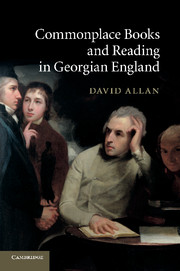Book contents
- Frontmatter
- Contents
- List of abbreviations
- Acknowledgements
- PROLEGOMENON
- PART I ORIGINS
- 2 ‘Many Sketches & scraps of Sentiments’: what is a commonplace book?
- 3 A very short history of commonplacing
- 4 Commonplacing modernity: Enlightenment and the necessity of note-taking
- PART II FORM AND MATTER
- PART III READERS AND READING
- PART IV ANCIENT AND MODERN
- PART V TEXTS AND TASTES
- PART VI ANATOMISING THE SELF
- ENVOI
- Bibliography
- Index
2 - ‘Many Sketches & scraps of Sentiments’: what is a commonplace book?
Published online by Cambridge University Press: 03 May 2011
- Frontmatter
- Contents
- List of abbreviations
- Acknowledgements
- PROLEGOMENON
- PART I ORIGINS
- 2 ‘Many Sketches & scraps of Sentiments’: what is a commonplace book?
- 3 A very short history of commonplacing
- 4 Commonplacing modernity: Enlightenment and the necessity of note-taking
- PART II FORM AND MATTER
- PART III READERS AND READING
- PART IV ANCIENT AND MODERN
- PART V TEXTS AND TASTES
- PART VI ANATOMISING THE SELF
- ENVOI
- Bibliography
- Index
Summary
I am now in the Country, and employ most of my Time in reading, or thinking upon what I have read. Your Paper comes constantly down to me, and it affects me so much, that I find my Thoughts run into your Way …
The Spectator, 2 September 1712It is easy enough to see why the task of repeatedly ‘thinking upon what I have read’ – as one of The Spectator's contributors excitedly described his own bookish meditations – appeared quite so necessary and so beneficial to early eighteenth-century people. For it seemed merely a natural corollary of the far-reaching consequences of reading that close attention should indeed be given to each and every aspect of their own experiences with texts. This unwavering conviction, however, never led to what often resulted, usually but not always described by English contemporaries as ‘commonplace books’, taking a consistent physical form. Nor for that matter did near-universal acceptance of reading's transformational role inspire a broad consensus among either theorists or ordinary readers as to the precise purposes for which structured note-taking might be undertaken. Most intriguingly, continuing disagreement about what a commonplace book was for, and so necessarily about how it ought actually to look, seems to have arisen because, with critical consequences for how it eventually came to be approached in the Georgian period, commonplacing, as we shall find in succeeding chapters, had already enjoyed a history almost as long as it was convoluted.
- Type
- Chapter
- Information
- Commonplace Books and Reading in Georgian England , pp. 25 - 34Publisher: Cambridge University PressPrint publication year: 2010



